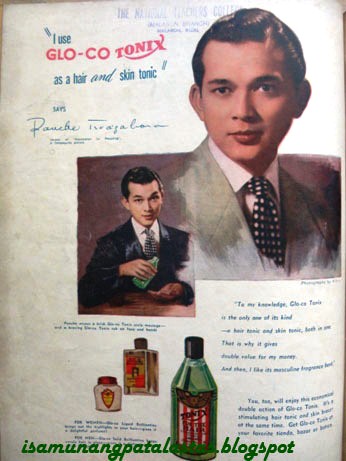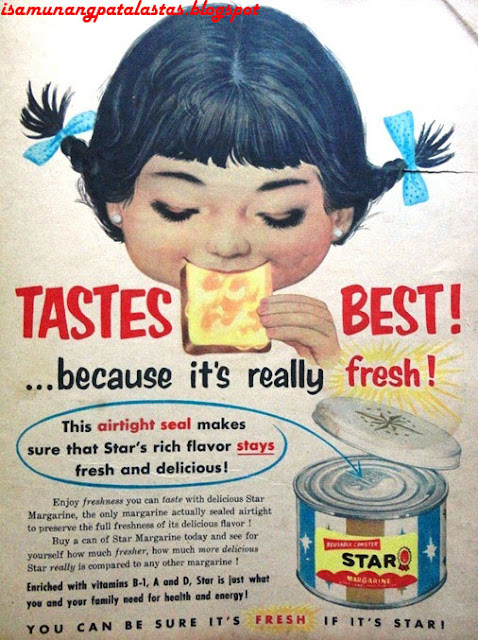 |
| Early 1936 GLO-CO print ad. |
Like Camay and Lux, GLO-CO—first advertised in 1936-- employed
famous movie stars to appear in their advertising—both Philippine male and female
icons of the silver screen. GLO-CO products were soon being branded as “Hollywood
beauty products”, despite the anachronism.
Its unisex line of grooming products, GLO-CO TONIX (along
with Brilliantine and Liquid Brilliantine) was actually pushed by male
celebrity endorsers—to give fragrant care to skin and hair. A few of these print
ads from 1951, which appeared on the covers of the leading movie magazines of
the day, appear below:
RODOLFO “RUDY” RUIZ says “a massage of GLO-CO TONIX
leaves my scalp stimulated—I feel wonderfully refreshed!”. This popular movie
actor began his career in the 1940s and was touted as the heir-apparent of the
late star Rudy Concepcion. He has already done a few films when he signed up
for the Merchant Marines, a job that took him to Japan where he met his wife,
Japanese actress Shirley Yamaguchi. The marriage was short-lived, Rudy returned
to Manila and moviemaking—doing well-received post war films like Aklat ng
Pag-Ibig with Rosa del Rosario (1951), Ang
Buhay at Pag-ibig ni Dr. Jose Rizal and Heneral
Paua (1956).
“I like its masculine fragrance best!”, says PANCHO
MAGALONA of GLO-CO TONIX. The debonair
son of a Philippine senator, Pancho was
one of the most well-known leading men of the late 40s-50s. With his wife Tita
Duran, he starred in many Sampaguita Pictures blockbuster movies that catapulted
the Tita-Pancho love team to national popularity. He appeared in some Hollywood
films like The Hook (with Kirk Douglas) and Merrill's Marauders (with Jeff
Chandler) that were shot in the Philippines. This Famas Best Actor ( 1958, "Hanggang sa Dulo ng Daigdig") is also
best-known as the father of the late master rapper, Francis Magalona.
“There’s nothing better than GLO-CO TONIX for perfect grooming”, says the actor-director-producer FERNANDO POE SR., The celebrate movie personality made 1930s films like Zamboanga and Giliw Ko, and also directed the first Darna film in 1951. The Spanish mestizo movie icon is also a doctor of dental medicine and a member of the Philippine army. Poe died in 1951 of rabies, at the peak of his career and in the middle of a film production, so this GLO-CO print ad was one of the last project he finished. He is the father of another Philippine movie legend, Fernando Poe Sr., one of his sons with Bessie Kelly.
“There’s nothing better than GLO-CO TONIX for perfect grooming”, says the actor-director-producer FERNANDO POE SR., The celebrate movie personality made 1930s films like Zamboanga and Giliw Ko, and also directed the first Darna film in 1951. The Spanish mestizo movie icon is also a doctor of dental medicine and a member of the Philippine army. Poe died in 1951 of rabies, at the peak of his career and in the middle of a film production, so this GLO-CO print ad was one of the last project he finished. He is the father of another Philippine movie legend, Fernando Poe Sr., one of his sons with Bessie Kelly.
Other handsome movie stars featured in GLO-CO TONIX ads included
Jose Padilla Jr. , Manuel Conde, Efren Reyes, Armando Goyena, Tony Arnaldo and
Oscar Moreno. Looking at these ads, you could see that that they are
professionally-crafted and photographed, had a single-minded promise (“excellent
hair and skin care that leaves a pleasant fragrance”), and strategically placed
as back covers of magazines. No wonder, GLO-CO remained at the forefront of personal
and beauty care through the rest of the 1950s.

















